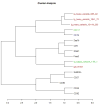Computational deconvolution of gene expression by individual host cellular subsets from microarray analyses of complex, parasite-infected whole tissues
- PMID: 27025770
- PMCID: PMC8023401
- DOI: 10.1016/j.ijpara.2016.02.003
Computational deconvolution of gene expression by individual host cellular subsets from microarray analyses of complex, parasite-infected whole tissues
Abstract
Analyses of whole organs from parasite-infected animals can reveal the entirety of the host tissue transcriptome, but conventional approaches make it difficult to dissect out the contributions of individual cellular subsets to observed gene expression. Computational deconvolution of gene expression data may be one solution to this problem. We tested this potential solution by deconvoluting whole bladder gene expression microarray data derived from a model of experimental urogenital schistosomiasis. A supervised technique was used to group B-cell and T-cell related genes based on their cell types, with a semi-supervised technique to calculate the proportions of urothelial cells. We demonstrate that the deconvolution technique was able to group genes into their correct cell types with good accuracy. A clustering-based methodology was also used to improve prediction. However, incorrectly predicted genes could not be discriminated using this methodology. The incorrect predictions were primarily IgH- and IgK-related genes. To our knowledge, this is the first application of computational deconvolution to complex, parasite-infected whole tissues. Other computational techniques such as neural networks may need to be used to improve prediction.
Keywords: Bioinformatics; Bladder; Deconvolution; Gene expression; Microarray; Mouse model; Schistosoma haematobium; Schistosomiasis.
Copyright © 2016 Australian Society for Parasitology Inc. Published by Elsevier Ltd. All rights reserved.
Figures







Similar articles
-
Schistosoma haematobium egg-induced bladder urothelial abnormalities dependent on p53 are modulated by host sex.Exp Parasitol. 2015 Nov;158:55-60. doi: 10.1016/j.exppara.2015.07.002. Epub 2015 Jul 6. Exp Parasitol. 2015. PMID: 26160678 Free PMC article.
-
Transcriptional profiling of the bladder in urogenital schistosomiasis reveals pathways of inflammatory fibrosis and urothelial compromise.PLoS Negl Trop Dis. 2012;6(11):e1912. doi: 10.1371/journal.pntd.0001912. Epub 2012 Nov 29. PLoS Negl Trop Dis. 2012. PMID: 23209855 Free PMC article.
-
Urinary schistosomiasis: Schistosoma haematobium infection diagnosed by histopathology.Indian J Pathol Microbiol. 2017 Oct-Dec;60(4):614-615. doi: 10.4103/IJPM.IJPM_182_16. Indian J Pathol Microbiol. 2017. PMID: 29323093 No abstract available.
-
Targeting molecular signaling pathways of Schistosoma haemotobium infection in bladder cancer.Virulence. 2011 Jul-Aug;2(4):267-79. doi: 10.4161/viru.2.4.16734. Epub 2011 Jul 1. Virulence. 2011. PMID: 21788729 Review.
-
The role of estradiol metabolism in urogenital schistosomiasis-induced bladder cancer.Tumour Biol. 2017 Mar;39(3):1010428317692247. doi: 10.1177/1010428317692247. Tumour Biol. 2017. PMID: 28345469 Review.
Cited by
-
An enduring legacy of discovery: Margaret Stirewalt.PLoS Negl Trop Dis. 2017 Aug 17;11(8):e0005714. doi: 10.1371/journal.pntd.0005714. eCollection 2017 Aug. PLoS Negl Trop Dis. 2017. PMID: 28817582 Free PMC article. No abstract available.
References
Publication types
MeSH terms
Substances
Grants and funding
LinkOut - more resources
Full Text Sources
Other Literature Sources

